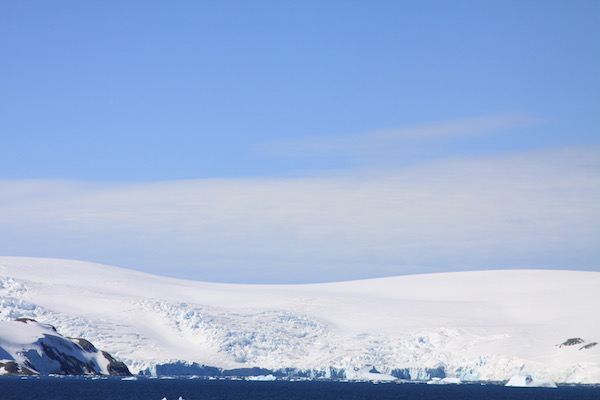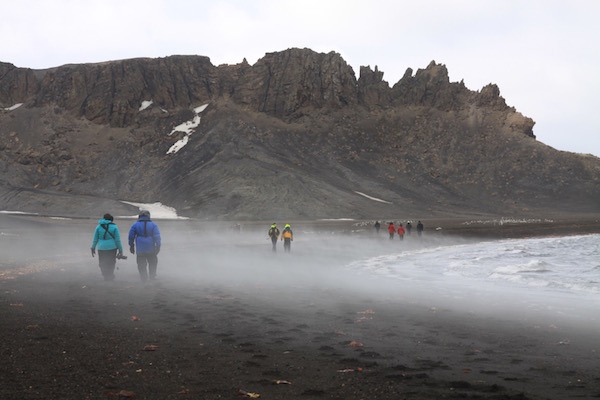For those of you just joining us, I recently returned from a week-long expedition to Antarctica. Since coming back to civilization, I’ve been posting about the experience. In previous “episodes,” I presented a preview, talked about the Wildlife, and the History. Today, I’m covering the role Science plays down south. There’s a lot more to come, too!

We visited several research stations. This one, Port Lockroy, has since been converted into a museum about Antarctic Research. A highlight of visiting a station was getting a Passport Stamp. While in Antarctica, we visited bases belonging to U.K., Chile, Argentina, and Russia.
There are mountains in The United States that appear on stamps, are visited by millions, and have become sources of national pride and international envy. Simply put, they pale in comparison to many of the mountains we stumbled across in Antarctica. There are so many of these giant mountains that many of them don’t even have names yet. In fact, there are likely some that no human has yet to lay eyes on!
And the landscape is still evolving. Deception Island, for example, is an active volcano, which last blew in 1969. While we were there, one of the passengers had a watch with a thermometer on it (people brought a lot of toys with them). When he stuck it in the sand, it read 110 degrees Fahrenheit. The air was about 30 degrees. As you would imagine, this meant there was a lot of water vapor with a distinct odor of sulfur. It was slightly less offensive than the penguin guano.
While we were at the British Base Port Lockroy, we saw an avalanche, which would have been a significant story back in The States. When it began, I was talking with one of the professionals stationed at Lockroy.
She was unaffected when she said, “Oh. Look. An avalanche off of that mountain there.”
In Antarctica, such terrain-altering events are everyday occurrences.

Until I got to Antarctica, I’d never seen a glacier. Now that I’ve been there, I’ve seen at least one hundred.
And that brings up the controversial topic of climate change. As far as I could tell, there was a lot of ice in Antarctica at the height of summer. Now, I don’t have historical context, so I sought some. The Captain of our ship readily admitted that there is less ice than there has been in the past. He’s seen it decline in his time working in the Antarctic. He spends the Northern Summer in the Arctic and he said he’s noticed the same thing there.
When I asked the few scientists we came across, they agreed. One fellow put it fairly eloquently.
He said, “There are a few things just about everyone agrees on. First, this isn’t new; temperatures have fluctuated for millions of years. Second, it’s happening faster than it has ever happened before.”
They know this because of ice core drilling. Ice experts (yes, that’s a job) have massive drills, which they aim at the ice and pull out slices of ice that stretch back hundreds of thousands of years. Glaciers are actually made up of compressed snow that, under pressure, becomes ice. As the snow falls, it captures air. The air is then locked into the ice as bubbles. Scientists then analyze the air bubbles in the ice to determine CO2 levels at the time the snow fell. With this information, they can determine greenhouse gas levels and temperatures.
Some of the ice appeared to have an electric blue color. It was unlike anything I’d ever seen in nature. Here’s why: Most often, the electric blue color is associated with ancient ice – sometimes tens of thousands of years old. Old ice has less air because it spent so much time on the bottom layer of a glacier. The air bubbles are effectively forced out by the pressure. The less air, the less red light it reflects, leaving only the blue spectrum.
This radical ice science has a very practical purpose: One night, a group was able to bring back some of this so-called “blue ice” for us to have with our drinks. I can report to you that old ice is good for scotch. Which is a less controversial subject than climate change. I didn’t ask the Meditators for their impression of the topic.
Today, Antarctica is governed by the Antarctic Treaty of 1959. It respects and ignores the claims made by a number of nations, including the United States. It says, basically, “Look, we know you say this is your land, but it really doesn’t belong to anyone.” And, apparently, it’s working. The scientists in Antarctica seem to get along regardless of the diplomatic stress that may exist between their nations. I guess a challenging environment and a desire for scientific truth bring people together.
Among many other things, the Treaty prevents exploration — and exploitation — of any potential natural resources. It went into force in 1961, currently has 53 member nations, and is due to expire in 2048 when either (1) we’ll no longer need whatever natural resources exist under the ice; or (2) we’ll have the technology to get whatever natural resources exist under the ice. Frankly, I’m hoping for option number one.
Antarctica is well-maintained. We were required to wear special boots, which we washed before and after a landing. We couldn’t eat or drink on the Continent, nor could we leave anything behind. I never did learn what the consequences were for such indiscretions. Perhaps that’s a good thing.
In tomorrow’s episode, I’ll be sharing some of my favo(u)rite photographs from the journey! Stay tuned!






